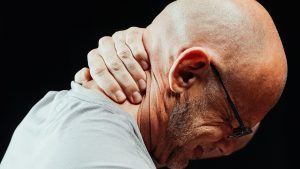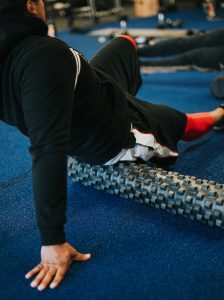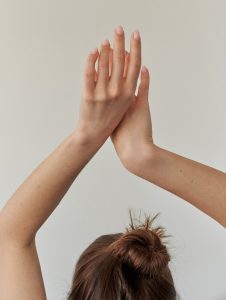Tagged Under:
Ouch! Easy Fixes for 5 Common Teacher Pains
Repetitive motions and all-day schedules put music educators at risk of physical pain. Here are a few ways to stay healthy
Sometimes, being a music teacher is a pain in the neck. Literally.
As much as music educators love their jobs, teaching can be brutal on their bodies. According to the Society for Music Teacher Education, “Music teachers are known to be at high risk for many occupational health issues.” It cites common musculoskeletal disorders linked to music educators’ roles, such as a choral conductor with shoulder pain or a band director experiencing back problems from lugging equipment around.
 Is Music Hazardous to Your Health?
Is Music Hazardous to Your Health?
The act of playing an instrument, while joyous, places the body into unnatural positions. That’s why, according to a MedPage Today research study that was conducted by Witten/Herdecke University in Cologne, Germany, two-thirds of professional musicians live with chronic pain. That study found that the top areas of pain were the back, shoulder, neck and wrist/hand. This discomfort was linked to the area of the body most stressed by the instrument played by a musician. For example, brass players were more likely to have back pain from holding a heavy instrument like a tuba or French horn, while string players and flutists tend to suffer more from arm and shoulder pain.
Let’s start with some overall habits that can help music educators avoid pain, regardless of which instrument or vocal classes are being taught:
- Take frequent breaks — about every half hour if possible — to stretch or rest.
- Practice proper posture and share those best-posture practices with your students.
- Because stress can cause muscular tension, according to an article on the American Psychological Association website, try to reduce stress overall. That’s easier said than done for a busy music educator, but adequate sleep, regular physical exercise, social support and meditation can all help tamp down stress levels.
- If you do experience pain, promptly make an appointment to see your healthcare provider because it’s easier to treat pain when it starts, rather than after it’s become a chronic, months-long problem.
Here are some tips for using flexibility and strength exercises, as well as adapting repetitive movements — from head to toe.
 Tight Neck and Shoulders
Tight Neck and Shoulders
Spent all week with a violin or viola (and, um, middle schoolers)? Well, it’s no wonder you’ve got a pain in your neck. Yoga Journal notes that the anatomy of the neck and shoulders is both complex and extremely mobile, making it particularly prone to injury from overuse. According to a metastudy of the research on yoga and neck pain, yoga has been found to have a significant effect on pain intensity, improves range of motion, and may help with overall anxiety. To soothe tight necks and strengthen shoulders, try these yoga asanas: Cobra Pose, Bow Pose and Eagle Pose (how-tos from Yoga Journal are shown here).
Wrist/Hand Pain
The repetitive motions of piano playing can result in achy joints, stiff fingers and sore forearms. Professional pianists know how to properly align themselves and how to get the bench height right, but don’t forget this simple fix, too: raise your hands above your head occasionally throughout the day. This may help reduce the risk of carpal tunnel syndrome, by reducing fluid that accumulates and avoiding pressure on the median nerve in the wrist.
To warm up with your students before a keyboard lesson, try some of the fun, kid-friendly exercises from New Zealand-based piano teacher Ruth Power. Her brief video shows how to strengthen wrists and increase the range of motion in hands, with moves like “The Mermaid” and my personal favorite, “The Zombie.”
Low-Back Pain
Some chronic, low-back pain comes from sitting at a desk or computer, while other music educators find they develop back pain from holding an instrument, such as a trumpet, aloft. The Alexander Technique has been found to be a cost-effective, useful way to treat persistent back pain, according to the British Medical Journal. Popular with performers, the Alexander Technique teaches posture habits, and the mind-body connection of balance and alignment, with the goal being more freedom of movement.
 Tight Hips
Tight Hips
Sitting for hours at a time, such as when teaching or sitting on a band bus, may cause tight muscles and pain in the hips. Try to stand up and move around a bit when possible. And when you get home, meet your new best friend: A foam roller. Foam rolling, or “self-myofascial release” if you want to be fancy, has been found to relieve hip pain, according to research published on the National Library of Medicine. Here are three stretches using a foam roller that you can easily do in your living room.
Sore Feet
Many music educators are on their feet, often in dress shoes, for multiple class periods. Try placing an anti-fatigue mat — those dense foam/gel pads professional chefs use — in the spot where you spend the bulk of your day standing. When you get home, make like a ballet dancer and soak feet in a bucket of warm water and Epsom salts for 20 minutes. According to the Cleveland Clinic, Epsom salts may reduce inflammation and help relax muscles. Or if you’re feeling brave, plunge those tootsies into a bucket of ice water for 10 minutes, which can alleviate pain. (Or at least make you forget you were having pain, because — yowza! — that’s cold!)
Hopefully, by being mindful of posture and movement throughout your teaching day, you can avoid some of the physical strain that comes with being a music educator. And come the weekend? Massages, long baths or yoga classes are all wonderful, healing rewards for all your hard work.
















